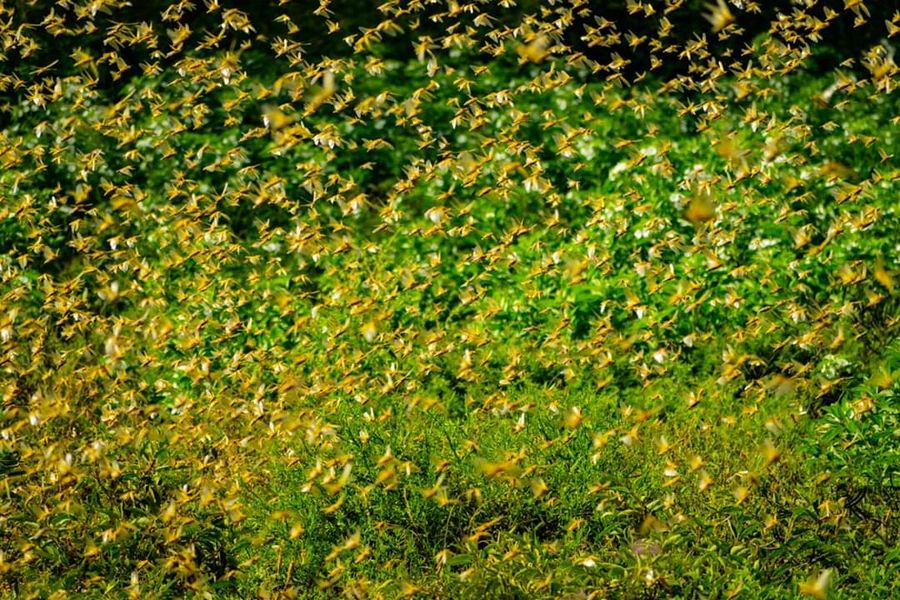
A swarm of desert locusts invade parts of Mwingi in Kitui county, Kenya, on Feb. 19, 2020. They have already destroyed hundreds of hectares of crops including millet, sorghum, green grams and maize among other crops. (Xinhua/Fred Mutune)
Kenyan farmers have been in a dilemma as planting season nears amid climate change and locust invasion.
NAIROBI, Feb. 20 (Xinhua) -- About this time a few years ago, George Ambuche, a maize farmer in Kitale of western Kenya, would be busy tilling his land in preparation for the planting season, which began at the onset of the rain season in March.
However, it is about 10 days to March and Ambuche is not bothered about preparing his farm yet. "Until I see the rains, that is when I will till the land," he said on phone on Tuesday.
"Last year, I lost money I had spent on fertilizer, hiring tractors and seeds because I had to replant since the rains delayed. Once bitten, twice shy," he added.
His predicament is shared by thousands of farmers across the east African nation as the country grapples with the effects of climate change. In the past, Kenyan farms would have been full of activity about this time of the year.
Tractor owners would now be as busy as bees, moving from one farm to another, ploughing or harrowing the land in readiness for planting maize as they charge at least 2,000 shillings ( about 20 U.S. dollars) per acre.
Not anymore. Only the hard-nosed optimists, who are few amid the climate crisis, are daring to do early ploughing.
A majority of farmers have adopted a wait-and-see attitude due to the unpredictable rains. Last year, instead of March, the rains started in May and lasted for about a month instead of three, according to the Meteorological Department.
And for the second season, which runs from October to December, rains were so heavy that they extended to January 2020, destroying crops.
"The weather has become too erratic that no one is getting it right, not the Meteorological Department, nor the traditional rainmakers. This is because of climate change," said Beatrice Macharia of Growth Point, an agro-consultancy.

A swarm of desert locusts invade parts of Mwingi in Kitui county, Kenya, on Feb. 19, 2020. (Xinhua/Fred Mutune)
The unpredictability has left millions of farmers in dilemma as Kenya's agriculture is rain-fed, added Macharia.
"I don't know whether I should plant maize this season or not because the locusts are just next door in Embu and spraying has not helped," said Martin Kariuki, a farmer in Nyeri, adding that he will wait and see.
Climate-related pests like fall armyworms and locusts exacerbate the situation for Kenyan farmers.
Kenya is currently grappling with locust invasion, the worst in 70 years, according to the Food and Agriculture Organization.
The insects have ravaged crops and vegetation in 18 counties, a majority of them semi-arid.
Efforts to contain them in the last two months have borne little fruit, with the Minister of Agriculture Peter Munya on Monday appealing to Kenyans to be patient as the government steps up aerial and ground spraying.
Chris Kiptoo, Principal Secretary of the Ministry of Environment, noted that Kenya and the entire eastern African region is vulnerable to the vagaries of climate change thus the country must prioritize mitigation measures.
To harvest about twenty 90-kg bags of maize in Kenya's breadbasket regions, it costs between 200 dollars and 300 dollars, according to agriculture think-tank Tegemeo Institute.
This means it costs an average of 15 dollars to produce a bag of maize. Amid slowdown in economic growth, this is money Kenyan farmers are not willing to lose amid the unpredictability of the rains.
With Uganda and Tanzania also struggling with erratic weather and locust invasion, east Africa may be staring at a food crisis. ■



